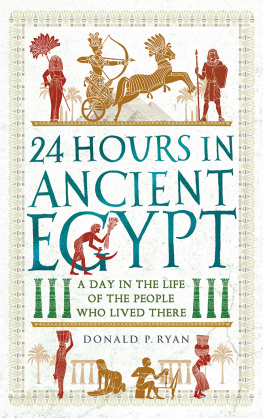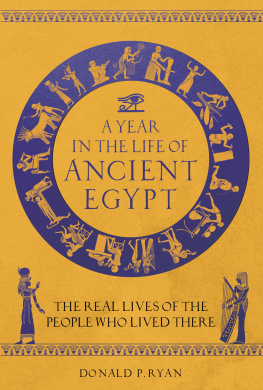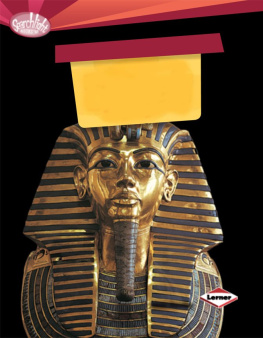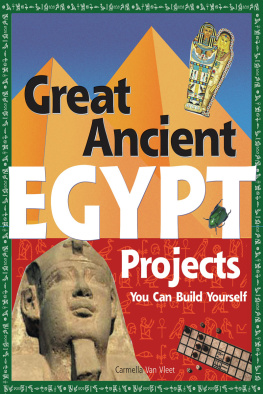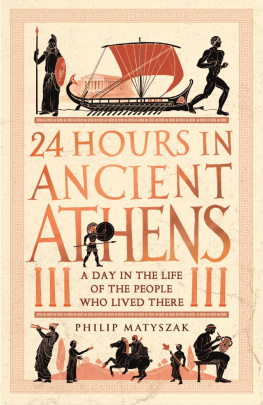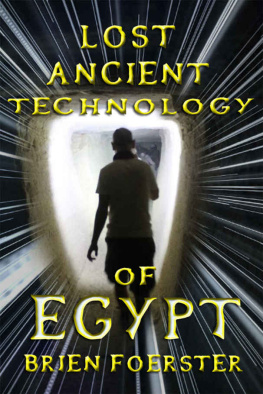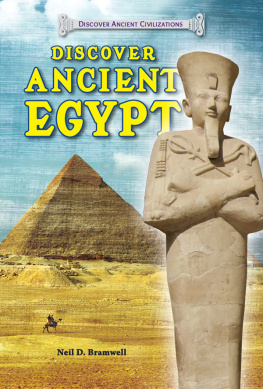First published in Great Britain in 2018 by
Michael OMara Books Limited
9 Lion Yard
Tremadoc Road
London SW4 7NQ
Copyright Donald P. Ryan 2018
All rights reserved. You may not copy, store, distribute, transmit, reproduce or otherwise make available this publication (or any part of it) in any form, or by any means (electronic, digital, optical, mechanical, photocopying, recording or otherwise), without the prior written permission of the publisher. Any person who does any unauthorized act in relation to this publication may be liable to criminal prosecution and civil claims for damages.
A CIP catalogue record for this book is available from the British Library.
ISBN: 978-1-78243-911-0 in hardback print format
ISBN: 978-1-78243-955-4 in ebook format
Follow us on Twitter @OMaraBooks
www.mombooks.com
In memory of Dorothy Dottie Shelton, who lived a life of joy and generosity.
CONTENTS
Of all the intriguing peoples of the ancient past, the Egyptians seem to hold a special allure for the modern world. Ruined monuments covered with a fascinating script, massive temples and pyramids, and incredible archaeological discoveries all add to the mystique surrounding a truly old and mostly vanished society.
Compared to ancient Greece and Rome, two of the other great civilizations of the ancient world, Egypt has not left us with a vast and diverse array of surviving texts that give us insights into almost anything that might interest us. The average Egyptian was illiterate and the majority of the surviving texts relate to things royal, religious and funerary. Still, enough bits and pieces have come down to us to allow Egyptologists to paint a reasonable portrait of its culture in its many facets, including a scattering of private letters and treatises about topics such as medicine. The practice of painting or sculpting scenes of daily life on the walls of the tombs of the elite visions of an afterlife in a perfected version of the world they lived in while alive have greatly benefited scholars. So, too, has the custom of equipping such tombs with actual food, clothing, furniture and other provisions.
A few abandoned villages have also survived. Although established in order to facilitate building projects such as the construction of pyramids and royal tombs, they were situated in arid places away from the Niles banks and thus avoided obliteration by the cyclical flooding of the river. Excavations of these sites have offered us precious and valuable clues to help us understand ancient Egyptian ways of life.
The ancient Egyptians divided their day, measured from sunset to sunset, into twelve hours of the day and twelve hours of the night. (For the convenience of the reader, the modern convention of measuring a day as starting at midnight will be used.) In this book we will see what one of these days in the life of ancient Egypt was like, getting a glimpse into this vanished civilization through the eyes and experiences of twenty-four of its inhabitants, from the hard-working farmers, potters, weavers and soldiers at its core, to the divine ruler of Egypt himself with his complex entourage of bureaucrats. Each hour we will meet a different Egyptian, their lives, struggles and triumphs being of interest not only as vehicles for understanding what daily life might have been like for them, but also for what they can tell us about Egypt itself. Most of the characters and scenarios in each chapter are fictional but are underpinned by Egyptological knowledge, the intent being to provide slices of life in ancient Egypt in a realistic and, hopefully, entertaining fashion. A few, though, take their place in history including the ruler, Amenhotep II, his queen, Tiaa, and his vizier, Amenemopet.
The majority of Egyptians led relatively simple lives and loved their land, believing it to be the best place on earth. They called it Kemet, the Black Land, referring to the rich fertile soil along the banks of its vital river, which snaked north from distant lands to the south, and ultimately emptied out into a great sea. The sinewy Nile Valley in the south and the broad Delta in the north provided a natural division of Kemet into two lands, Upper and Lower Egypt respectively, as they were clearly distinguished. At one time, the regions were politically separate, but their unification under a single ruler was considered to be the beginning of Egyptian civilization, and the ruler was well noted as the king of both lands.
The English word Egypt is derived from the Greek word, Aigyptos, which seems to be derived from the ancient Egyptian word, Hut-ka-Ptah, meaning Mansion of the Ka (spirit) of Ptah. The popular god, Ptah, was associated with the ancient capital of Memphis and was a patron of craftsmen.
The Nile River really was at the core of Egypts existence. Its yearly period of flooding deposited rich, fertile silt that renewed the farmers productive fields. Its water provided a highway north and south, lots of fish to eat, water for irrigation and plenty of mud to make bricks. Off to the edges was the Red Land, the land of desert and arid mountains lots of sand and stone, a number of gold mines and the occasional oasis.
Other than the river, the most dominant part of the Egyptian world was the sun, that orange ball that provided heat and light, which descended into the west each evening to be reborn each and every day or so it was fervently hoped. The sun was the god Re, traversing the sky in a boat loaded with other gods, or perhaps it was propelled by a giant cosmic dung beetle, or engaged in a slow flight with the invisible wings of a divine hawk. In the Egyptian mindset, all of these things could be true at the same time.
Although the sun was dominant in Egypts physical world, the perceived presence of gods was everywhere and they represented both the physical and the abstract. The gods numbered in the hundreds, with temples and shrines of various sizes peppering the landscape. They all had their start long before the beginnings of Egyptian civilization when a creator god, Atum, arose from a mound of slime emerging from the primordial waters of Nun. Atum, himself, proceeded to create pairs of other gods, male and female, who played major roles in the creation and maintenance of a new world. Geb and Nut were the land and the sky; Shu and Tefnut were air and moisture, and together they comprised the basic components of a liveable environment. Of supreme importance at the time this book is set was the god Amun-Re, who was honoured by temples proliferating on the east bank of the river, and who was given credit for much of Kemets success.
Our twenty-four stories will take place in Thebes, a political and religious capital, during year twelve of the reign of Aakheperure Amenhotep (Amenhotep II), c. 1414 BC, during the Eighteenth Dynasty of the chronological period that scholars have named the New Kingdom (c. 1550 to 1069 BC). The New Kingdom was a time of Egypts empire building, with its eastern influence reaching to the edge of Mesopotamia and its southern dominance deep into Nubia. It was a time of growing prosperity, with Egypts rulers initiating both military and commercial foreign expeditions of impressive proportions. Amenhotep II bragged about his superior skills as an athlete and warrior, leading his troops into battle in a chariot pulled by brawny prancing horses. Back at home he was a great builder of temples, palaces and, of course, many monuments to himself. The New Kingdom was certainly an interesting time in human history, and arguably the apogee of Egypts ancient civilization and, as the following chapters will show, an ideal era to serve as an introduction to ancient Egyptian culture. Lets take a trip back in time to Kemet and spend a day with the people who lived there.

